Engaging in regular physical activity is vital for everyone, including individuals who use wheelchairs.
Wheelchair aerobics is an inclusive form of exercise that allows those with limited mobility to improve their health and well-being through movement.
These workouts are designed to raise the heart rate and enhance overall fitness levels without the need to stand or walk.
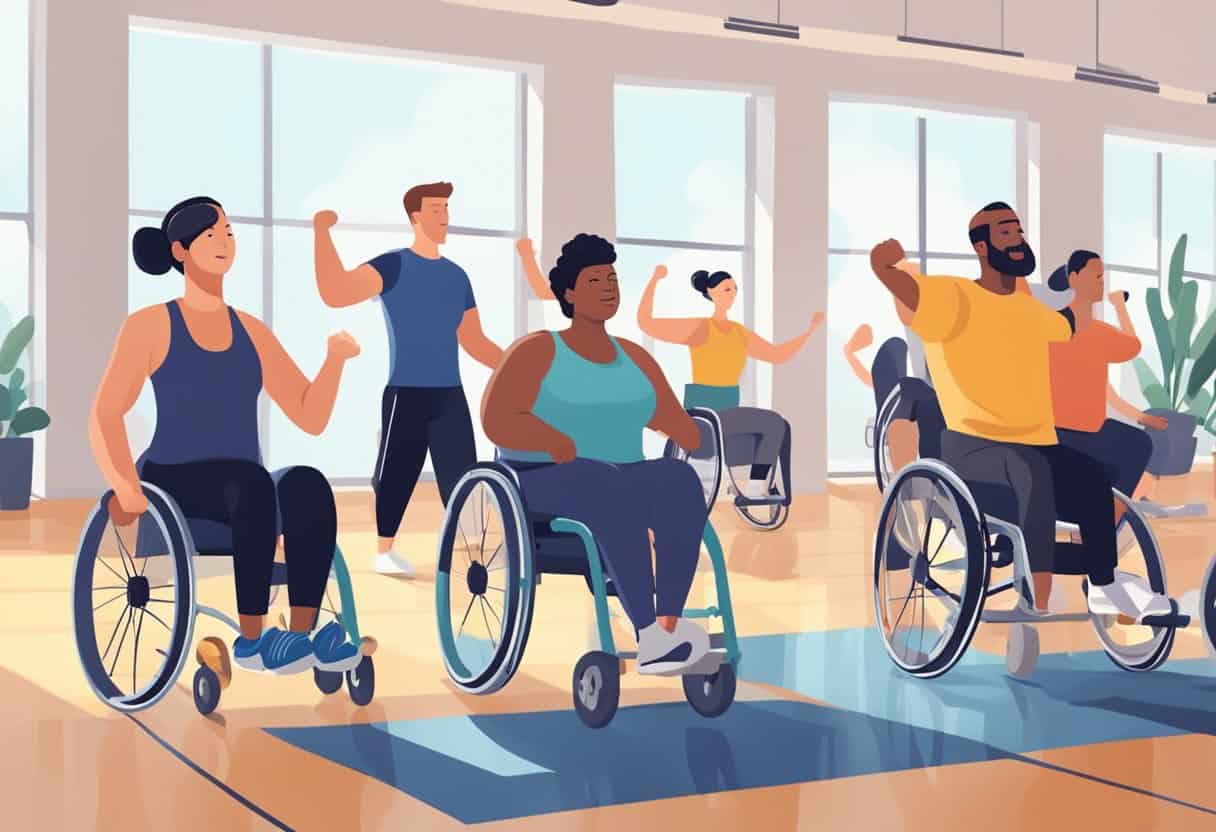
Performing aerobic exercises while seated is not only feasible but can be highly effective.
Wheelchair aerobics incorporates various movements to activate different muscle groups, focusing on building strength, flexibility and cardiovascular endurance.
Engaging in these exercises regularly can lead to numerous health benefits, including improved muscle tone, better circulation, and enhanced respiratory function.
Key Takeaways
- Wheelchair aerobics improves cardiovascular health and increases strength.
- Exercises can be tailored to individual abilities and goals.
- Regular practice can enhance overall well-being and day-to-day functioning.
Understanding Wheelchair Aerobics
Wheelchair aerobics is an inclusive fitness program designed to provide cardiovascular exercise and improve overall endurance for individuals who use a wheelchair.
As a wheelchair user, engaging in regular aerobic workouts can help you enhance your muscle strength, flexibility, and range of motion.
Key Components of Wheelchair Aerobics:
- Cardiovascular Exercise: Activities like chair aerobics increase your heart rate, similar to traditional aerobics. Chair aerobics consist of seated repetitive movements that help burn calories and elevate cardiovascular health.
- Muscle Strength: Through the use of light weights or resistance bands, you can perform strength training motions focused on building muscle.
- Flexibility: Stretching exercises are crucial for maintaining a good range of motion and preventing stiffness.
Incorporating wheelchair exercises into your exercise routine not only targets the upper body but can also engage core muscles. Consider the following exercises to get started:
- Arm cycles or lifts
- Chest expansions
- Shoulder stretches
For resistance workouts, lighter weights or resistance bands can provide adequate tension. This is essential to promote muscle growth and improve joint mobility.
Emphasizing mobility, wheelchair aerobics allow you to engage in dynamic movements while considering the limitations of your current level of mobility. It’s important to adjust each exercise to meet your personal requirement, ensuring a safe workout experience.
To continue improving your fitness, try to vary your routines. You may incorporate videos specifically designed for wheelchair aerobics, to give you more structured sessions. Remember to pace yourself to build endurance gradually without overexertion. Regular wheelchair aerobics can be a rewarding way to maintain your health and boost your energy levels.
Benefits of Wheelchair Aerobics
Engaging in wheelchair aerobics offers a wide array of benefits that can enhance your quality of life. Whether it’s through improved physical health, mental well-being, or social engagement, this form of exercise caters to different aspects of health and lifestyle.
Physical Health Advantages
Wheelchair aerobics provide significant health benefits including improved heart health and weight management. By incorporating activities like resistance band exercises and simulated swimming motions, you can:
- Burn calories efficiently, which aids in maintaining a healthy weight.
- Strengthen various muscle groups, with a focus on back muscles and balance.
Regular participation can also lead to increased bone mass and enhanced overall physical activity levels, making daily tasks easier to perform.
Mental and Emotional Well-being
Regular aerobic exercise positively influences your mood and can be a strong ally against depression and stress. By setting and achieving goals, you boost your self-esteem. Moreover:
- Increased energy levels.
- Better sleep quality.
These factors contribute to a substantial improvement in your mental and emotional health.
Improving Daily Functionality
The strengthening exercises involved in wheelchair aerobics translate to improved daily functionality. Enhanced muscle strength helps with:
- Transfers in and out of your wheelchair.
- Increased independence in day-to-day activities.
These benefits collectively facilitate a more autonomous lifestyle, directly impacting your quality of life.
Social and Recreational Aspects
Participating in wheelchair aerobics often takes place in a group setting which promotes social interaction. This kind of physical activity can be both fun and engaging with elements like music and synchronizing movements with others.
Additionally, it opens doors to wheelchair sports, creating opportunities to engage in competitive or recreational sports, such as wheelchair basketball or racing.
| Aspect | Benefit |
|---|---|
| Physical Health | Improved cardio, muscle strength, balance |
| Emotional Well-being | Elevated mood, lower risk of depression |
| Daily Functionality | Better mobility and independence |
| Social & Recreational | Fun, music, and community bonding |
In summary, wheelchair aerobics provide comprehensive benefits that touch on multiple facets of your life, ensuring that you can stay active and enjoy a positive outlook.
Getting Started with Wheelchair Aerobics
Wheelchair aerobics offers a versatile way to keep fit, focusing on activities that enhance cardiovascular health and improve strength. Before jumping in, ensure you tailor your experience to your needs and abilities for a safe and effective workout.
Consulting Healthcare Providers
Before starting any new exercise program, consult with your healthcare provider to ensure these exercises are safe for your physical condition. Your doctor can help you identify any potential risks of injury and advise on the best way to proceed without exacerbating any pain, illness, or discomfort.
Setting Personal Goals
Align your exercise routine with clear and attainable goals to maintain motivation and measure progress. Whether it’s improving stamina, building muscle with resistance bands, or enhancing flexibility, defining your objectives paves the way for a tailored and rewarding aerobics program.
Importance of Warm-Up and Cool Down
Incorporate a comprehensive warm-up to prepare your body for the workout, and end each session with a cool down period to prevent dizziness or muscle strain. These should include gentle stretching and light exercises to gradually increase your heart rate before the main workout and reduce it afterward.
Choosing the Right Equipment
Select equipment that complements your goals and physical abilities:
- Weights: Consider using light dumbbells or free weights, which can be held during exercises to increase intensity.
- Resistance Bands: These can be used to enhance strength training without putting undue stress on your joints.
- Exercise Ball: An exercise ball can aid in maintaining balance and core stability during your workout.
When choosing equipment, prioritize items that are accessible and comfortable for you to use while seated.
| Equipment Type | Purpose | Consideration |
|---|---|---|
| Dumbbells | To add weight resistance to movements | Ensure they are light enough to start without strain |
| Resistance Bands | To improve strength and flexibility | Choose bands with suitable tension |
| Exercise Ball | To aid balance and core stability | Select a size that is manageable from your wheelchair |
Remember, regular exercise can significantly benefit your overall health, but it’s vital to approach it with awareness of your unique circumstances. Keep these guidelines in mind as you embark on your wheelchair aerobics journey.
Types of Wheelchair Aerobics Exercises
Wheelchair aerobics incorporate diverse exercises, focusing on improving cardiovascular health, enhancing muscle strength, and increasing flexibility. By adapting traditional aerobics for wheelchair users, these exercises offer a full-body workout that can be tailored to individual needs and fitness levels.
Aerobic and Cardio Workouts
Aerobic and cardio workouts aim to raise your heart rate and improve your endurance. These can include:
- Wheelchair Cardio Workout:
- Arm cycling
- Wheelchair sprints
- Wheelchair dance
Benefits:
- Boosts cardiovascular health
- Aids weight management
Strength Training and Resistance Workouts
To build muscle and increase upper body strength, you can engage in strength training and resistance exercises using:
- Resistance Bands
- Free weights
- Isometric exercises
Targeted Muscle Groups:
- Biceps and triceps
- Shoulders
- Chest and back
Strength Exercise List:
- Shoulder press
- Chest squeeze
- Rowing motion
Flexibility and Balance Exercises
Enhancing your flexibility and balance is important for overall mobility and injury prevention. Key practices include:
- Wheelchair Yoga
- Stretching routines
Focus Areas:
- Improving range of motion
- Upper body toning
- Core stability for better balance
Safety Measures and Injury Prevention
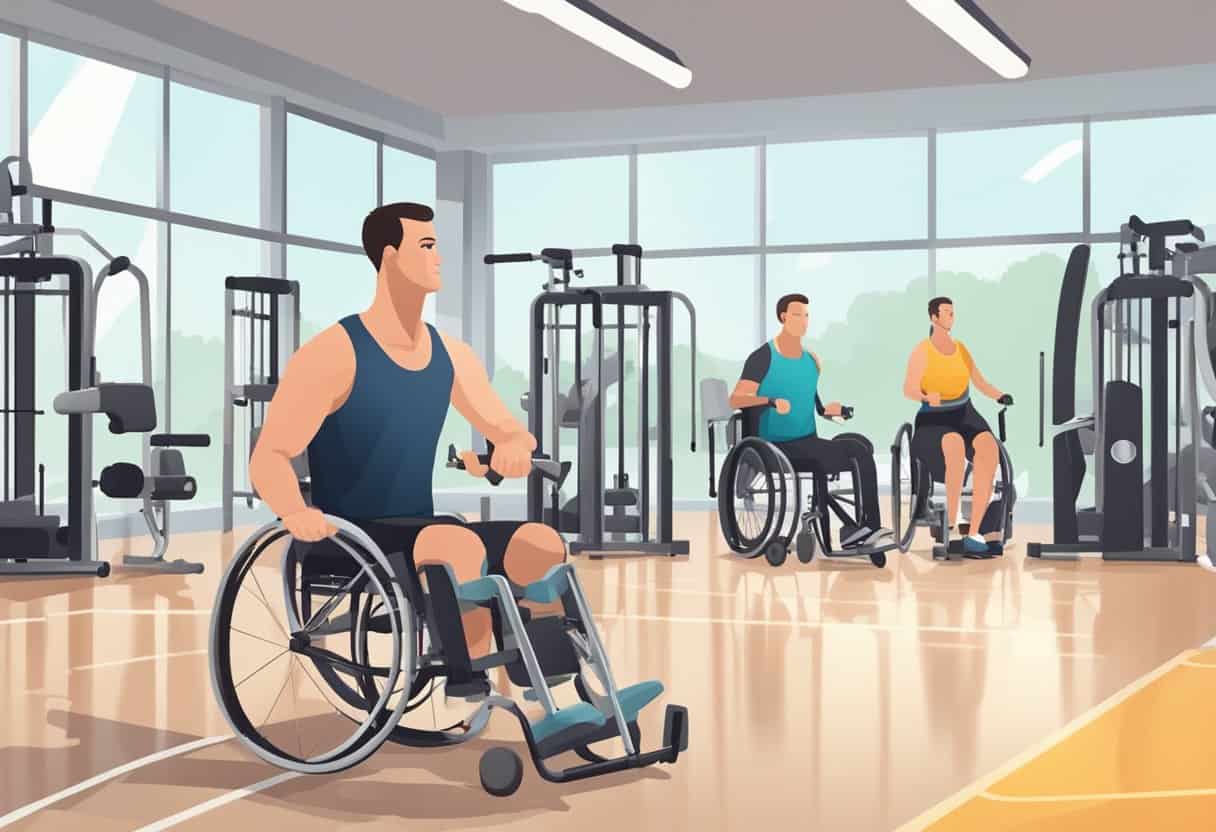
Before beginning wheelchair aerobics, understanding and applying key safety measures can significantly reduce your risk of injury and ensure a productive workout experience.
Understanding Limitations and Risks
It’s crucial to know your physical condition and any disabilities that may affect your ability to perform certain aerobic exercises. Consult with a doctor to understand the specific risks associated with your condition. Recognize signs of potential injuries such as discomfort, pain, or dizziness.
Proper Technique and Supervision
When engaging in wheelchair aerobics, using the correct form is essential. Ensure you are:
- Instructed by a qualified coach or trainer who can offer guidance on proper technique.
- Following an exercise routine suitable for your condition, with modifications if necessary.
A supervised session in a gym environment can help prevent injuries associated with improper exercise execution.
Identifying and Managing Discomfort
Maintain awareness of your body’s signals and react accordingly:
- Stop any movement that causes unexpected discomfort or pain.
- Communicate any issues with your trainer or doctor.
| Discomfort | Potential Cause | Action to Take |
|---|---|---|
| Muscle Fatigue | Overexertion | Rest and hydrate |
| Joint Pain | Poor Technique | Adjust technique with coach input |
| Sharp Pain | Possible Injury | Cease exercise, consult a doctor |
By following these safety measures, you’ll position yourself for a safe and beneficial wheelchair aerobics session.
Creating a Personalized Exercise Plan
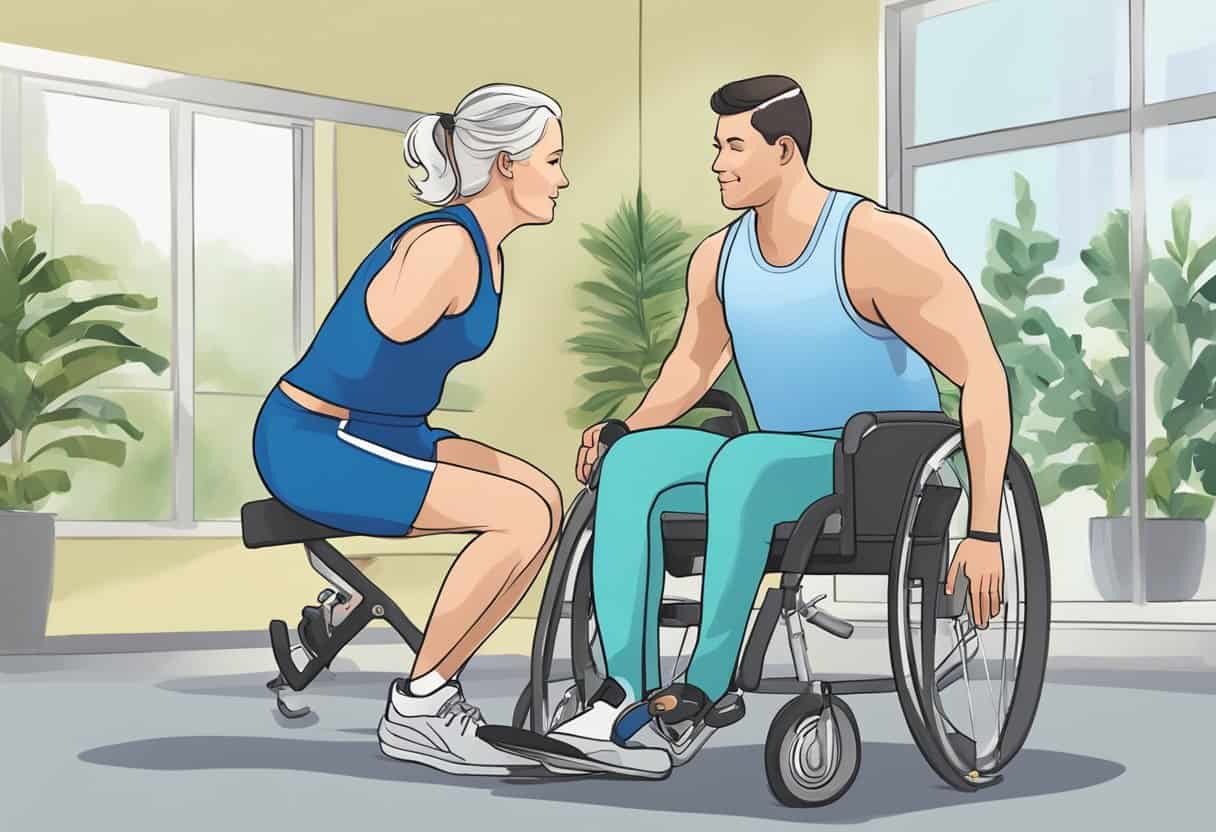
Crafting a personalized exercise plan tailored for wheelchair aerobics involves setting clear goals and understanding how each component—frequency, intensity, and duration—plays a pivotal role in structuring your routine for maximal benefit.
Routine Structuring for Optimal Results
Your exercise routine should be a balanced mix of aerobics, strength training, and flexibility exercises. Structuring your routine begins with establishing a daily routine that integrates with your physical condition and lifestyle. Define your goals for energy improvement, motivation, and endurance building.
- Frequency: Start with 3 days a week, aiming for a gradual increase to 5 days as your endurance and strength improve.
- Intensity: Gauge your initial ability and increase the intensity as you progress, ensuring you’re always challenged without risking injury.
- Duration: Aim for at least 20 minutes of continuous aerobic activity, extending up to 60 minutes as your condition allows.
| Stage | Frequency | Intensity | Duration |
|---|---|---|---|
| Beginning | 3 days/week | Low | 20 minutes |
| Developing | 4 days/week | Moderate | 30 minutes |
| Established | 5 days/week | Challenging | 60 minutes |
Continuing Progress and Adjusting Goals
Track your progression by maintaining a log of your workouts, which should include notes on frequency, intensity, and duration. Adjust your goals as you achieve them to ensure continual improvement and to keep your motivation high. Regularly reviewing and updating your plan helps maintain a positive energy dynamic and boosts self-esteem.
- Evaluate your progress every two weeks.
- Update your routine to challenge your increasing strength and endurance.
- Incorporate new activities to keep your routine fresh and exciting.
Remember, personalizing your exercise plan is a dynamic process, where listening to your body and being willing to adapt is key to maintaining a successful wheelchair aerobics regimen.
Supplementary Resources and Support
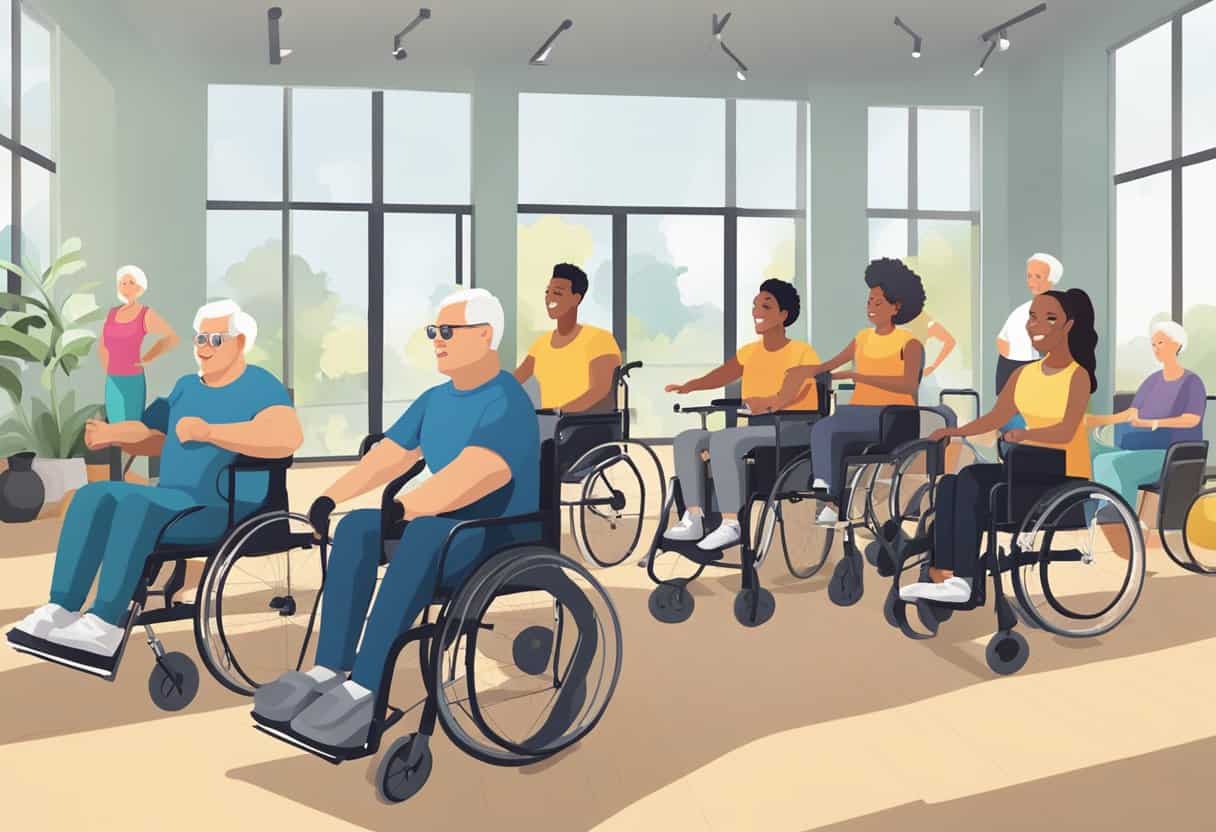
To achieve success in wheelchair aerobics, it’s essential to have access to the right resources and support systems. This section provides details on guided videos, community exercises, and adaptable equipment that can enhance your workout experience.
Guided Workout Videos and Tutorials
Start your wheelchair aerobics journey with a variety of guided workout videos and tutorials. These resources can provide you with the structure you need and guidance on proper form. You’ll find instructors like Coach Nicole and Jessica Smith, who offer a range of chair exercise videos accessible on platforms such as SparkPeople. They cater to different fitness levels and can be easily incorporated into your routine.
- For structured workouts, check out:
Community and Group Exercises
Participation in community and group exercises offers not only a way to stay active but also a social avenue to connect with others. Local gyms and community centers often host group classes, while online communities can be a platform for sharing experiences and encouragement.
- Locate local group exercise options:
- Search for wheelchair aerobics classes at nearby fitness centers.
- Explore organizations that promote wheelchair sports and group activities.
Adaptable Equipment and Technology
Having the right equipment can make all the difference in your workout. Adaptable equipment, such as resistance bands, hand weights, and exercise balls, ensures that you can perform a variety of exercises safely and effectively.
| Equipment Type | Description | Example Use |
|---|---|---|
| Resistance Bands | Versatile for strength training and flexibility | Arm and shoulder toning |
| Hand Weights | Add extra resistance for muscle building | Enhance arm exercises |
| Exercise Ball | Improve balance and core strength | Seated abdominal workouts |
Remember, incorporating these resources into your wheelchair aerobics regimen empowers you with the tools and support necessary to maintain an active, healthy lifestyle.
Navigating Challenges and Setbacks
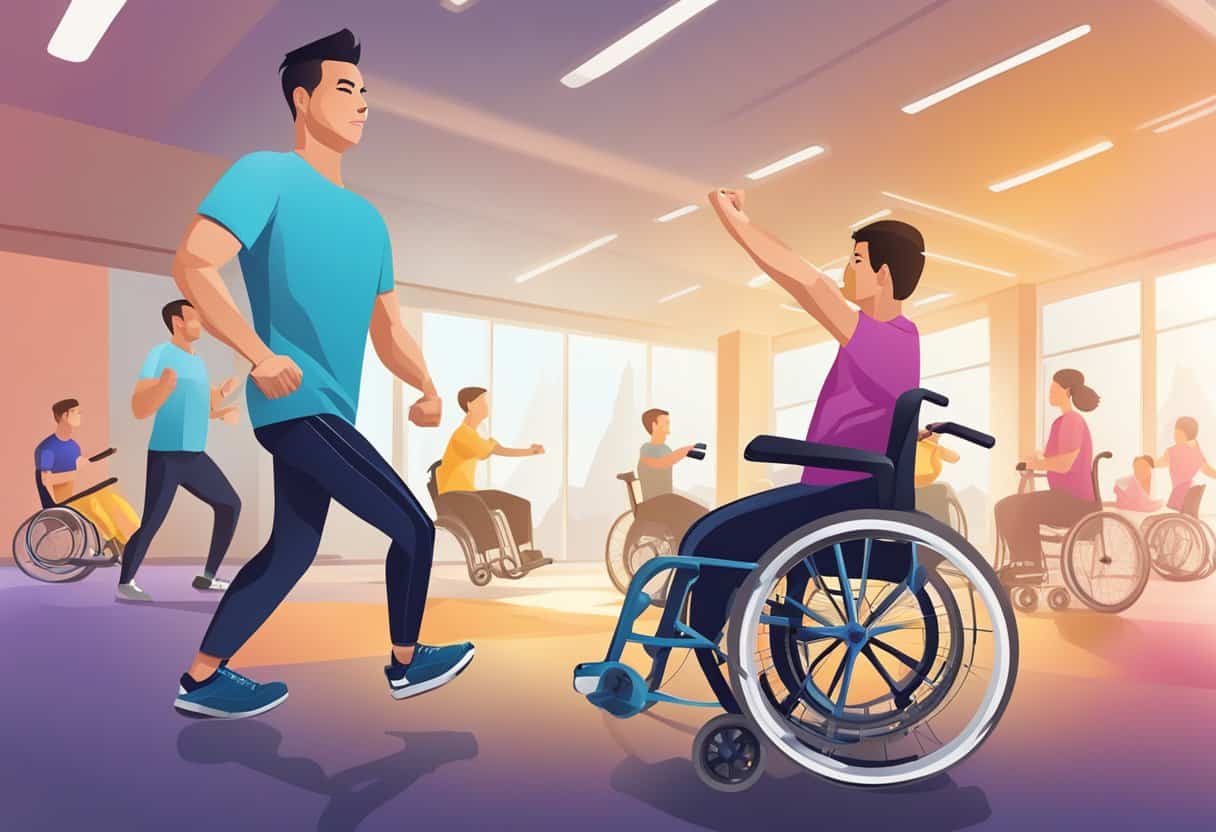
When embarking on the journey of wheelchair aerobics, you will encounter obstacles that test your resolve. This section navigates you through managing frustrations, adapting your routine for sustained participation, and finding the support to stay motivated.
Managing Expectations and Frustrations
Expectations play a pivotal role in staying committed to your aerobics routine. Begin by setting realistic goals—small victories can significantly boost your self-esteem and bolster resilience. Avoid disappointment by understanding progress may be slow, and setbacks are part of the journey.
- Realistic Goal Setting: Aim for achievable targets like increasing session duration by a few minutes each week.
- Tracking Progress: Regularly monitor advancements, no matter how minor they seem.
Adaptation Strategies for Continuous Engagement
To maintain interest and diversity in your aerobics activities, regularly incorporate exercise variations. Adaptations to exercises can help you overcome physical limitations while keeping your daily routine enriching.
- Introduce new equipment or techniques
- Modify movements to fit your comfort and ability level
| Strategies | Description |
|---|---|
| Equipment | Utilize resistance bands or weights to add variety. |
| Movement | Adjust range of motion or substitute actions. |
| Session Timing | Schedule workouts when you feel most energized. |
Seeking Motivation and Encouragement
Motivation stems from internal desires and external support. Engage with a community for peer support and participate in groups that offer encouragement. Apply motivational strategies like listening to uplifting music or setting exercise-related rewards.
- Join online forums or local groups
- Celebrate milestones with friends, family, or fellow participants
Develop a support network to share experiences and strategies for overcoming challenges. This camaraderie can be invaluable to your mental health and long-term resilience. Remember, every day is a new opportunity to strengthen your body and mind through wheelchair aerobics.
Conclusion

By merging exercise with your daily life, you’ll find that these activities can not only improve your physical health but can also be a rewarding element of your daily routine.
The aim should be long-term maintenance of your health, thereby reducing risks related to sedentary behavior. Commit to your fitness journey with confidence knowing that wheelchair aerobics is a practical step towards enhancing your overall quality of life.

